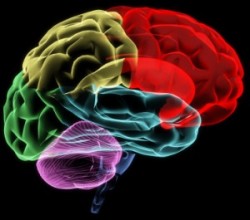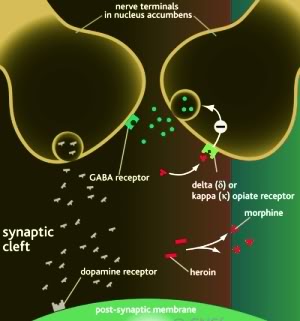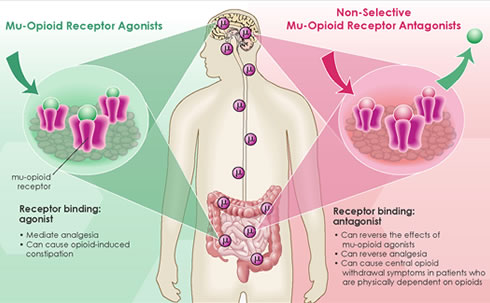The term “opiate agonist” is one that not a lot of people are familiar with. However, for those who have experienced opiate addiction in the past, or who have watched friends and loved ones struggle with that condition, opiate agonists can be the cure for what ails many addicts.
To learn more about opiate agonists or for help finding treatment, call 800-442-6158 Who Answers? .
What Are Opiate Agonists?
The simplest description of an opiate agonist is that it is a chemical that acts in ways similar to an opiate, but its real purpose is to trick the brain. An opiate agonist then is a chemical which gives the user the same feeling that he or she would receive if they were taking an opiate (an endorphin rush, complete with pain numbing and euphoria), but it does so without any of the actual effects that an opiate has on the body. In short, an opiate agonist is a placeholder, occupying the receptors in the brain where an opiate would be attached if there was actually an opiate in the person’s body at the time.
How Do They Work?

Opiate agonists give the user the same effects as would an endorphin.
Opiates, as many people know, are a family of drugs that includes chemicals that come from opium like heroin, methadone, morphine and others. These drugs have been used for pain as well as recreationally, and both situations can lead to severe physical dependence. When a user takes an opiate the drug binds with opiate receptors, which are particular proteins in the nervous system. This binding causes certain pathways to open, and that results in the release of endorphins. This is why opiates have the power to reduce pain and to induce a feeling of euphoria; they alter the way the body’s chemistry works and cause the release of the feel-good chemicals.
The difficulty with opiates is that these opiate receptors become accustomed quite quickly to being occupied. So what was once the introduction of a new chemical quickly becomes an expected part of your body’s chemical environment. This leads to addiction, both physical as well as mental, and the user often has to use greater and greater amounts of the opiate in order to get the same rush as before. Stopping the use, or even stepping it down, results in withdrawal symptoms that can be as mild as shakes and sweats and as extreme as intense pain, nausea and in some circumstances problems with internal organ function.
That’s where opiate agonists come in. An opiate agonist could best be thought of like caffeine free diet coke; it is meant to provide the same sensation, but without all of the problems of the real thing (opiates in this case). The result is that the body can often adjust to the lack of real opiates while the brain and the opiate receptors go on thinking that they’re still getting regular doses of the real thing. It makes them a much safer method for stepping down an opiate addict and eventually getting him or her off the dosage completely over time.
How Are Agonists Administered?
Opiate agonists are indistinguishable from other opiates to the common observer. The only way to be sure what they are is often to read the contents on the syringe or bottle that they come in. Like many forms of opiates, such as heroin and morphine, opiate agonists are often delivered via a syringe or other, intravenous device. Depending on the state of the patient and his or her ability to work with needles, these doses can be self-administered or they can be administered by personnel at a clinic or hospital. The latter is particularly true for those who are going through rehabilitation and are looking to get off of opiates despite their addictions. Some opiate agonists though can be taken orally, which is an easy solution for those who prefer to stay away from needle use.
What is The Difference Between Agonists and Antagonists?
Opiate antagonists are another kind of drug out there for helping to stop the effects of opiate addiction. However, that said, they are very different substances and they have completely different effects on the body when they’re introduced into a patient’s system. An opiate agonist, as already described, attaches to the opiate receptor and convinces the body that it has opiates in its system even though it isn’t experiencing many of the effects associated with opiates.
Opiate antagonists work in a way that is almost completely different from how opiate agonists work. When introduced into a patient’s bloodstream the opiate antagonists don’t bond with the opiate receptors present in the patient’s body; instead they block the receptors completely. Where an opiate agonist might be thought of as a block that fits into a gap, an opiate antagonist is like a small wall built around the opening that stops any opiates from bonding with it. This makes sure that no bond of any kind can be formed, and it makes certain that the body can’t gain the effects of any opiates. Even if someone gets opiates into their bodies the antagonists make it impossible for those opiates to reach the receptors.
To find a treatment program that offers medication assistance, call 800-442-6158 Who Answers? .
What is a Partial Opiate Agonist?
A partial opiate agonist is, in brief, a chemical that can switch back and forth to act as either an agonist (a chemical that bonds with and activates a receptor) or an antagonist (a chemical that blocks the receptor and makes sure that nothing can bond with it). These particular chemicals are very useful for doctors that need something that can activate or block the receptors as needs be. While it might not always be the first choice for a doctor, a partial opiate agonist does provide a useful treatment option for circumstances where other options simply won’t do.
What is Opiate Agonist Therapy?
Opiate agonist therapy is a form of substitution therapy. It’s when a person is addicted to a substance, and that person is then given a less harmful, though similar substance is introduced into the patient’s system. Methadone treatment is based off of this theory; if someone is addicted to heroin and that heroin can be switched with something less addictive and less dangerous that makes it easier to step down and beat addiction then that is a simple solution to the problem. The hard part of course is trying to be sure the patient doesn’t get addicted to the new substance, as occasionally happens with methadone and other forms of substitution therapy.
That’s what makes opiate agonists such a great form of therapy for those who are addicted to opiates and are looking for a way to stop. Because of how opiate agonists operate, allowing the body to naturally beat the addiction while keeping the receptors and the mind occupied, they allow addicts to step down much more gradually during the therapy. With a medical observer making sure that the patient progresses smoothly, it can be a much easier ride for the patient as he or she comes down from the height of addiction.
Opiate Agonist List
There are a lot of drugs out there that can act as opiate agonists. When added to the list of drugs that can act as partial opiate agonists, it can get to be pretty long. However, some of the more common opiate agonists that people are likely to come into contact with are as follows:
- Naltrexone, which can be taken orally or with a needle
- Naloxone, which is more commonly called Narcan, is used to help stop overdoses. Injected or snorted through the nose, it can save someone’s life in the event of taking too much of an opiate.
- Buprenorphine, similar to morphine in many ways, it results in longer relief and smaller chances of physical dependence.
These are just some of the more common opiate agonists that people are likely to come into contact with. There are others on the market, and depending on a person’s needs and body chemistry there may be more appropriate choices available for their use.
Get opiate addiction treatment help today by calling our toll-free number at 800-442-6158 Who Answers? .










